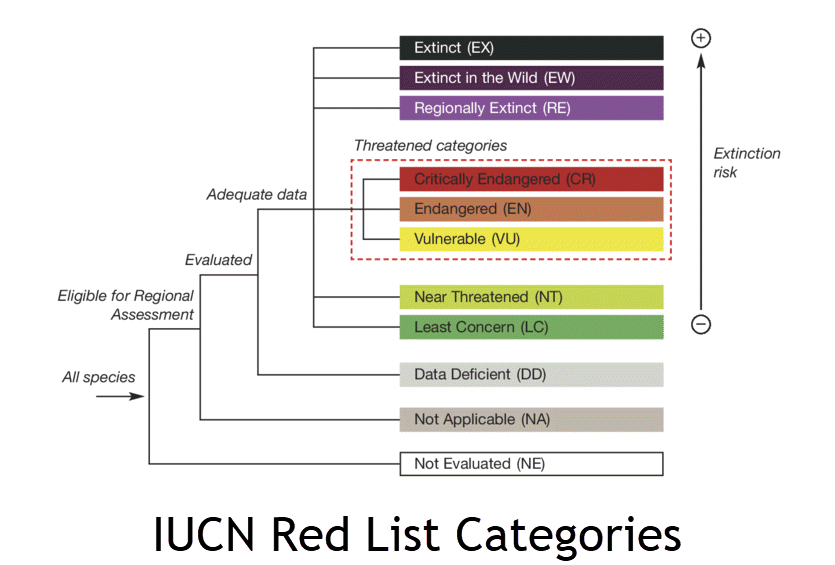The International Union for Conservation of Nature (IUCN) is a worldwide organization founded in 1948. It maintains and publishes the IUCN Red List of Threatened Species, a detailed list of the conservation status of thousands of biological species on this planet, including wild cats. Categories of classification include Extinct, Extinct in the Wild, Critically Endangered, Endangered, Vulnerable, Lower Risk, Data Deficient, Not Applicable and Not Evaluated.
A wild cat is considered Critically Endangered when it is facing an extremely high risk of extinction in the immediate future, and there has been a reduction of at least 80% of the population over the past 10 years. This is determined by several factors, including direct observation, the total number of wild cats considered appropriate for the species, a decline in the number of wild cats living in a particular area. When a wild cat has been labeled Critically Endangered it has been determined that the species or subspecies has less than 50 mature cats in existence.
A wild cat species is considered Endangered when it is at a high risk of extinction in the near future, and there has been a 50% reduction in the population of the species over the past 10 years. A wild cat is listed as Endangered by the IUCN based on several criteria, including direction observation, how many wild cats are considered appropriate for the species and a reduction in the number of wild cats living in an area. When a wild cat is labeled Endangered, that species or subspecies has less than 2500 mature individuals in existence.
When a species has been listed as Critically Endangered or Endangered, it is at high risk for extinction in the future.

More About Endangered Species
A Critically Endangered species has experienced a loss in population of 80% or more over the past 10 years or the past three generations, whichever time period is longer. Critically Endangered can also mean an 80% population reduction that is expected to take place in the next 10 years (or next three generations). A species can also be labeled Critically Endangered if it has become extremely fragmented (living in scattered locations or even a single location). Other criteria that is used includes:
- A population of less than 250 mature individuals with an expected continuing decline of 25% over the next three years (or one generation), and severely fragmented or living in a single location.
- A population of less than 50 mature individuals
- There is a 50% change of extinction within the next 10 years or three generations.
A species is listed as Endangered when there is a high risk of extinction with a population reduction of at least 50% over the next 10 years or three generations, the species’ population is severely fragmented and can only be found in no more than 5 locations. Other criteria can include:
- The population has less than 2500 mature individuals with an expected decline of 20% within 5 years or two generations, the population is fragmented or the species only lives in one location.
- There are less than 250 mature individuals
- There is a 20% chance of extinction within 25 years or five generations.
You can read more about IUCN classification here.
Many wild cats, including big cats and small wild cats, are currently listed as Critically Endangered, Endangered, or Near Threatened.
List of Endangered Big Cats
West African lion (Panthera leo senegalensis) – Critically Endangered
South China tiger (Panthera tigris ssp. Amoyensis) – Critically Endangered – Possibly Extinct in the Wild
Sumatran tiger (Panthera tigris ssp. sumatrae) – Critically Endangered
Amur leopard (Panthera pardus ssp. orientalis) – Critically Endangered
Javan leopard (Panthera pardus ssp. melas) – Critically Endangered
South Arabian leopard (Panthera pardus ssp. nimr) – Critically Endangered
Asiatic cheetah (Acinonyx jubatus venaticus) – Critically Endangered
Central Asian leopard, North Persian leopard, Persian leopard, West Asian leopard (Panthera pardus ssp. saxicolor) – Endangered
Sri Lankan leopard (Panthera pardus ssp. kotiya)- Endangered
Asiatic lion (Panthero leo ssp. Persica) – Endangered
Snow leopard (Panthera uncial) – Endangered
Tiger (Panthera tigris) – Endangered
Amur tiger (Panthera tigris ssp. altaica) – Endangered
Indochinese tiger (Panthera tigris ssp. corbetti) – Endangered
Malayan tiger (Panthera tigris ssp. jacksoni) – Endangered
Bengal tiger (Panthera tigris ssp. tigris) – Endangered
List of Endangered Small Wild Cats
Iberian lynx (Lync pardinus) – Critically Endangered
Iriomote cat (Prionailurus bengalensis ssp. Iriomotensis) – Critically Endangered
Fishing cat (Prionailurus viverrinus) – Endangered
Flat-headed cat (Prionailurus planiceps) – Endangered
Scottish wildcat (felis silvestris grampia) – Endangered

